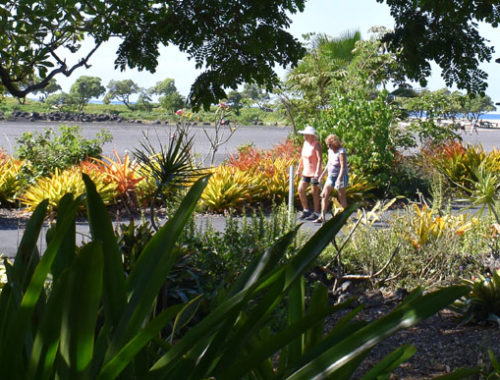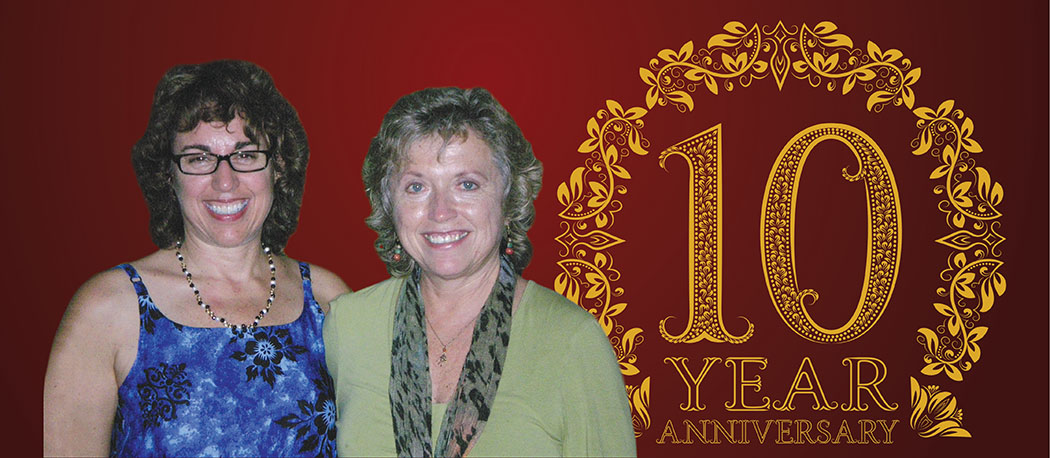
The Nene Project: GPS Tracking Reveals the Hawaiian Goose Doin’ What Comes Naturally
 By Fern Gavelek
By Fern Gavelek
Hawai‘i’s beloved state bird, the nēnē, is making a comeback, and a new Hawai‘i Island study has revealed some fascinating facts about the Hawaiian goose and how we can help it thrive.
The good news is the birds’ population has rebounded from a low of only 20 or 30 in 1950 to about 900 on Hawai‘i Island, and, surprisingly, they are now traveling the island more extensively than anyone thought. High-tech transmitters are sending back tracking data for a project code-named “Nēnē in the Space Age.”
The project, Satellite Telemetry of Hawai’i’s Endangered Goose, began in early 2009 and is wrapping up this spring. A collaborative effort between the U.S. Geological Survey (USGS) and the National Park Service, the study outfitted 11 nēnē ganders with solar-powered platform transmitter terminals (PTTs). Worn by the male nēnē like mini backpacks—each one carrying a luxury price tag of $4,000—the PTTs tell scientists where the nēnē are via precise GPS coordinates.
By February 2012, PTTs recorded the studied nēnē at about 12,000 islandwide locations. The coordinates provided daily insight to flight patterns and pit stops along the way, as well as preferred habitats for feeding, breeding and socializing.
Nēnē are thought to have made landfall in the Hawaiian Islands some 890,000 years ago. It’s estimated their population grew to an estimated 25,000 birds. Ancient Hawaiians gave clues as to where they commonly saw nēnē, naming locations after them, like Kīpuka Nēnē on the slopes of Mauna Loa.
According to Dr. Steven Hess, USGS wildlife biologist, the introduction of predators—rats, dogs, cats and mongoose—precipitated the decline in Hawai’i’s nēnē population beginning about 1,000 years ago. Unregulated hunting and habitat destruction further threatened the nēnē, which Hess explains, “is the most terrestrial of geese.”
“The bird’s plight had become so grave by 1949 that a captive propagation program was initiated,” says Dr. Hess, who is stationed at the USGS’s Pacific Island Ecosystems Research Center at Hawai‘i Volcanoes National Park. In 1950, there were only 20-30 birds known to exist in the wild—all of them on the Big Island. Dr. Hess credits “decades of captive breeding, releases into the wild, habitat management and predator control” for restoring nēnē to four of Hawai‘i’s largest islands.
Classified today as an endangered species, nēnē are given broad protections under law to recover to a self-sustaining population. There are roughly 900 nēnē currently on Hawai‘i Island and as many as 2,000 combined across four major islands, which include Maui, Kaua‘i and Moloka‘i.
The Science of Tracking Nēnē
According to Dr. Hess, wildlife managers noticed in the late 1990s that Big Island nēnē had “begun regularly moving” between leeward Kona, the isle’s windward side and the southern Kahuku areas.
“We questioned if nēnē were making direct flights between the sites or stopping along the way,” explains the wildlife biologist. “If the nēnē stopped, we wondered what were the threats and food in these habitats?”
The satellite telemetry tracking, it was felt, would be the best way to get the answers with the island’s dense and varied terrain. Ganders for the study were chosen from several locations where flocks frequented, such as Hawai‘i Volcanoes National Park (HVNP) and Big Island Country Club (BICC) in Pu‘uanahulu.
Once the data started coming in, the nēnē revealed their flight patterns and it was found they were once again roosting at their historic haunt of Kīpuka Nēnē, a rugged site high on Mauna Loa in HVNP’s Kahuku area. Also, it was noted the birds’ north-south and east-west island crossings were intersecting at Kīpuka ‘Ainahou in the island’s high saddle, where some of the last wild nēnē were observed.
“It was puzzling that birds discovered at Kīpuka Nēnē came from the Hakalau Forest National Wildlife Refuge some 50 miles away, yet the Hakalau population did not exist prior to 1996,” says Dr. Hess. He adds that the terrain of Kīpuka Nēnē has changed dramatically over time from an open ‘ohi‘a forest with small pools and sedges to one that had been altered by “one of the largest lava flows on Earth.” However, still the nēnē returned there.
Dr. Hess notes the behavior of nēnē reappearing in ancestral places makes researchers wonder if it took the captive-raised population 50 years “to figure it out” or had a small number of wild survivors passed this knowledge on to contemporary descendants? “We still don’t know for sure, but it seems to be catching on in a big way,” he adds.
The ganders also exhibited a pattern of seasonal movement—from lowland breeding grounds during the winter to high-elevation, non-breeding areas in the summer. The geese visited subalpine scrub during the summer, which is home to ‘ōhelo berry and pukiawe—traditionally their favorite foods.
In fact, Dr. Hess reports a nēnē was recorded at 9,100 feet, where temperatures reach freezing. “Birds are good at thermal regulation,” Dr. Hess explains. “They can adjust their feathers to their climate so don’t mind so much if it’s hot or cold.”
Looking at the habitats used by nēnē—low elevations with green ground cover for breeding and subalpine scrub for non-breeding—scientists found nēnē were dramatically changing their elevations. “That surprised us,” admits Dr. Hess. “Though early naturalists reported this kind of movement, we had never observed it as nēnē hadn’t done this for awhile.”
Telemetry also showed that Kīpuka ‘Ainahou acts like a “social magnet” between the BICC and Hakalau Refuge populations.
“We think Kīpuka ‘Ainahou is where youngsters are hooking up with potential mates and, if that’s the case, then there’s more interbreeding among populations,” notes Dr. Hess. “This is important because nēnē need to transcend their lack of genetic diversity.” He says low genetics is an issue because of inbreeding among the few captive pairs in the 1950s to save the species.
The Importance of Habitat Protection
Dr. Hess stresses wildlife managers are encouraged by the re-establishment of traditional nēnē movement patterns. “Nēnē in the Space Age” identified what locations are being used by nēnē today and why.
He explains, “If we want nēnē to behave naturally, we have to protect both their breeding and non-breeding areas.” He says it’s up to the state to manage the land and provide protection through the Department of Land and Natural Resources (DLNR), in partnership with the park service. “Their goal is to restore the land, like the subalpine scrublands, to its natural condition by keeping out predators and other invasive species.”
Some protection is already in the works. Nēnē, which mate for life, return each year to breed at HVNP. “We have a little over 200 birds either breeding in the wild, in the Kīlauea and Mauna Loa Strip areas, or in a two-acre ‘exclosure,’ which keeps out predators with a fence,” explains Dr. Rhonda Loh, natural resource chief at HVNP. She says a grassy lawn is mowed for the birds inside the exclosure, while the park’s other breeding birds forage for berries and grass in the wild.
“Sometimes we’ll assist birds breeding outside the pen by temporarily closing a park trail to minimize human disturbance to nesters,” continues Rhonda.
The Hawaiian Goose also breeds at BICC, where it’s warmly welcomed. The preservation and support of nēnē “represents BICC’s vision for the entire property,” according to Richard Oliver, the on-island, owner’s representative. He explains, “Proper turf management enables a good food source for nēnē and their goslings while our lakes provide great safe zones to evade predators. We know by the health of the nēnē population if we are indeed doing a good job for all BICC inhabitants and guests, including the nēnē.”
“The ponds at BICC are used by nēnē primarily for protection and bathing—they get most of the moisture they need for diet from grass,” details John Polhemus, a wildlife biologist. “Nēnē molt (shed their feathers) between February and May and for about a month are flightless, so the ponds provide an escape from predators.” He says nature “takes over the timing” when breeding adults molt and re-grow feathers so they and their young can fly together.
“It’s especially important to protect the breeding locations for nēnē so their populations can continue to recover,” emphasizes Polhemus.
John, who owns JT Productions, is contracted by the DLNR’s Division of Forestry and Wildlife to monitor the 130 nēnē making up the West Side Flock: those frequenting BICC, sections of Pu‘u Wa‘wa‘a and Waikoloa Village Golf Club.
At BICC, John hops on a golf cart and drives around doing a “roll call,” recording nēnē that are ID’d with colored bands to do periodic population counts. He also bands goslings and intervenes, when necessary, to help injured birds. “The frequency of injured or sick birds is low,” he says, and a Kona veterinarian has been employed when necessary. Some of the birds John monitors were first banded in the mid-90s and he makes sure their “bling” is fitted properly and “not a deterrent.”
BICC has a partnership with the new Hawai‘i Wildlife Center (HWC) in Kapa‘au, which has set a goal of receiving birds for rehabilitation starting May 2012. Since 2006, BICC has been donating a portion of its greens fees to HWC, which have totaled $2,500.
“We will be working with BICC to treat any sick or injured nēnē that come from the course,” says Linda Elliott, HWC president and center director. She points out HWC is the only facility that will be rehabilitating native birds from the entire Hawaiian archipelago.
“Getting the donation from BICC is important for our efforts of not only helping sick or injured birds, but also facilitating the conservation of nēnē and our other endangered birds,” continues Linda. “Big Island Country Club is a model for accommodating wildlife. They’ve included wildlife in everything they do, and they don’t have to.”
HWC, which completed major construction last November, has provided BICC with info and photography to provide guidelines for golfers using the course. In addition to nēnē, BICC is home to the endangered Hawaiian coot (‘alae ke‘oke‘o), black-crowned Night Heron (‘auku‘u), Hawaiian Hawk (‘io) and the short-eared owl (pueo).
While The Hawaiian goose is increasing in numbers, it still faces challenges of low genetic diversity, periods of drought and an ever-shrinking natural environment with non-native enemies.
Summing up the importance of protecting nēnē, Linda notes the challenge is to teach people “what human behaviors are best around nēnē so they can thrive.” She concludes, “We all need to understand and accept what we have to do to live with our environment and be good neighbors.” It’s up to everyone to help protect this beautiful and resilient state bird in its native habitats. ❖
Contact writer Fern Gavelek: ferng@hawaii.rr.com
All nēnē photos provided by Christina Cornett, Nēnē Research Specialist, Hawai’i Cooperative Studies Unit, University of Hawai’i at Hilo, Pacific Aquaculture and Coastal Resources Center
For more information:
hawaiiwildlifecenter.org
bigislandcountryclub.com/nature.html
nps.gov/havo
How We Can Best Live with Nēnē?
How can we help them to thrive?
One solution is to leave them alone.
“Nēnē are grazers, and feeding them decreases their proficiency at foraging in the wild, causing a variety of problems,” emphasizes wildlife biologist John Polhemus.
Feeding results in incorrect diet. Case in point is a female nēnē that lives at BICC year-round because she has an “angel wing.” The flightless condition is common among ducks and geese that are fed by humans, resulting in a nutritional imbalance.
“People think they are helping by putting out water and food—they aren’t,” stresses Polhemus. He says feeding nēnē from vehicles teaches the geese to get in the path of traffic.
Dr. Steven Hess, USGS wildlife biologist, adds, “If you live around nēnē, keep your pets away from them as dogs can kill adults and cats kill goslings.”
As nēnē are protected under the Endangered Species Act of 1973, it is illegal to kill, harm or harass them, including disturbing nesting individuals or altering their behavior. Violations can be reported by calling 808.887.6063.
October through April is the most sensitive time for nēnē because individuals are pairing up to nest and rearing goslings. Information signs at HVNP caution vehicles to slow down to watch for geese crossing the road and visitors are encouraged to keep a respectful distance when observing birds. “We want visitors to keep far enough away so as not to alter their normal behavior,” advises Dr. Rhonda Loh, natural resource chief at HVNP.


